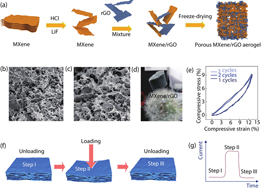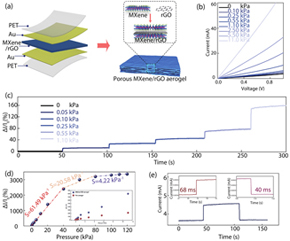Shufang Zhao, Wenhao Ran, Lili Wang, Guozhen Shen. Interlocked MXene/rGO aerogel with excellent mechanical stability for a health-monitoring device[J]. Journal of Semiconductors, 2022, 43(8): 082601
Search by keywords or author
- Journal of Semiconductors
- Vol. 43, Issue 8, 082601 (2022)

Fig. 1. (Color online) The characterization of the interlocked MXene/rGO aerogel composite. (a) Schematic illustration of the fabrication procedure of interlocked MXene/rGO aerogel. SEM images of interlocked MXene/rGO aerogel: (b) high magnification and (c) low magnification. (d) Optical image of interlocked MXene/rGO aerogel with lightweight feature placed on the dandelion. (e) Compressive stress-strain curves of the interlocked MXene/rGO aerogel at 12% strain under different cycles. (f) Structure change of interlocked MXene/rGO aerogel during the compression process and (g) the corresponding illustration of current change.

Fig. 2. (Color online) The sensing performance of the interlocked MXene/rGO aerogel-based pressure sensor. (a) Illustration of flexible pressure sensor. (b) The I–V curves of the flexible sensor. (c) Dynamic measurement of the sensor response with increased pressure from 0 to 1.1 kPa. (d) Sensitivity curves. Inset show the comparison of sensing properties of MXene/rGO aerogel and flat aerogel. (e) Current responses to loading/unloading 5.5 kPa on the sensor. The inserts give response time and recovery time of the sensor.
Fig. 3. (Color online) Sensing-performance of the interlocked MXene/rGO aerogel-based pressure sensor at different bending states. (a) The I–T curve with the bending angle increased from 30° to 90°. (b) The real-time I–T curve of the sensor in the 90° repeated bending-straightening process. (c) Response and recovery time under different cycles. (d) The bending stability test of the sensor under bending and releasing state.
Fig. 4. (Color online) MXene/rGO aerogel-based pressure sensor as a wearable device for health monitoring. (a) The pressure-sensitive response to the bending motion of a forefinger (inset: photograph of the device fastened to back of a forefinger with different bending angles). (b) Three cycles of bending the finger at 90°. (c) Human pulse (inset: photograph of the device placed onto a wrist). (d) The enlarged waveform of one of the pulses in (c).
|
Table 1. Comparison of pressure sensor performance.

Set citation alerts for the article
Please enter your email address



